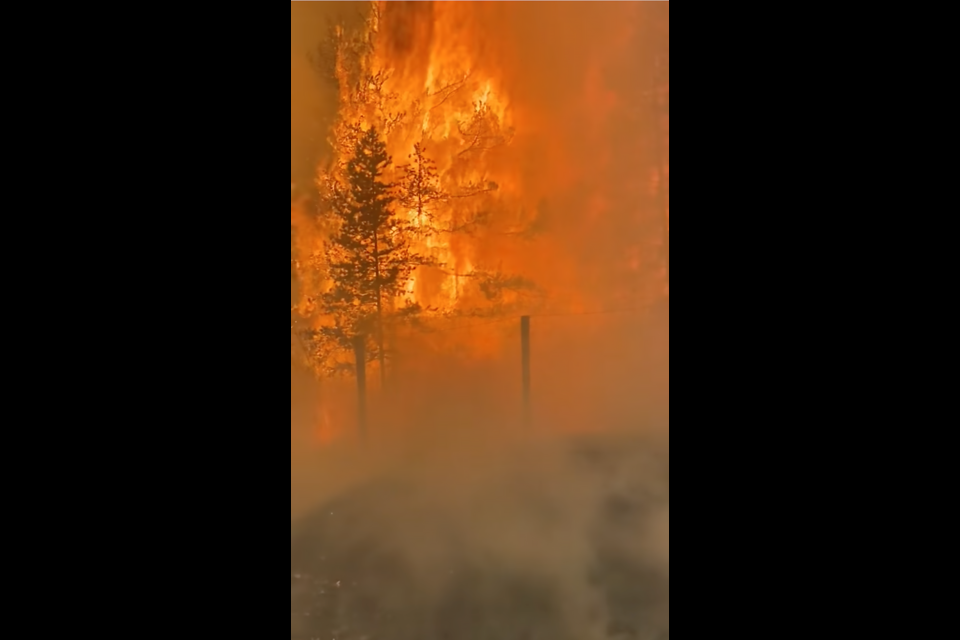BANFF – The results of an independent review of a prescribed fire that got out of control near the Banff townsite in spring are expected soon.
While the actual full after-action review (AAR) won’t be released, Parks Canada officials say they are hoping to have lessons learned and recommendations from the third-party review publicly released within the coming weeks.
“AARs are not released publicly due to the confidential nature of the process, to allow team members to speak in an open and safe environment,” said Alexandria Jones, a spokespers for Banff National Park, in an email.
“A response to the incident will be shared publicly. The response will include lessons learned from the incident.”
On May 3, preparation fire work ahead of a main prescribed burn in Compound Meadows got out of control, jumping from the west side of Banff Avenue to the east side. It was eventually contained to three hectares.
The out-of-control fire forced the evacuation of Banff Rocky Mountain Resort and Mount View Barbecue – a private event and reception area – as well as several horses from the Banff Light Horse Association corrals.
Guests were able to return on May 3, while horses were brought back to the corrals on May 7. However, three sheds at the corrals burned down, including one that belonged to the Brewster family who lost several treasured family heirlooms.
The iconic Bill Peyto entrance sign that welcomed people entering to the townsite burned to the ground and minor damage to wildlife fencing along the Trans-Canada Highway and to Mountain View Cemetery also occurred.
The fire got out of control as crews were black-lining – the pre-burning of grasses and shrubs adjacent to a control line before igniting a prescribed burn – to protect the wildlife exclusion fence along the highway.
Wind speeds jumped from 10 km/h to 28 km/h and the fire danger rating at the time was high, with temperatures in the mid-20s Celsius.
As a result of the out-of-control prescribed fire, Parks Canada cancelled the main prescribed burn in Compound Meadows, aimed at improving wildlife habitat and increasing fire protection, until at least fall 2024.
Though not all after-action reviews are done by third-party companies, Jones said they are a standard, necessary conclusion to any prescribed or wildfire operation in the national parks.
“All team members involved are asked to share their experiences and provide feedback for future learning,” she said.
“Recommendations from AARs are incorporated into future fire operations to ensure that high reliability organizations continue to improve processes and systems.”
Marie-Pierre Rogeau, who has 32 years of experience in fire research and is a fire ecologist living in Banff, raised concerns about the townsite’s vulnerability to fire following the May 3 escaped prescribed fire, penning an op-ed piece for the Rocky Mountain Outlook.
A supporter of Parks Canada’s prescribed fire program, she called on the federal agency to conduct a transparent, third-party review of what unfolded that day, ranging from what she called “ignored science and common sense, to operational oversights and lack of communication.”
“In addition, the Town of Banff needs to conduct its own review in terms of trust and reliance on Parks, how it will evaluate fire risk going forward, and its communication strategy through the Voyent Alert, which seriously downplayed fire risk to residents and campers on Tunnel Mountain,” wrote Rogeau, who has a Masters degree on the fire history of Banff National Park and PhD focused on fire regimes and the effect of topography on fire frequency in the Rockies.
Jones said prescribed fires are complex operations that can require several years of preparation and planning, and Parks Canada fire management specialists prepare a detailed plan before any work is done.
Each plan describes not only the environmental conditions needed to start the prescribed fire, she said, but also the necessary resources required to safely carry out the operation.
“Data and evidence regarding conditions, consultations, and resources are assessed right up until a final decision is made to proceed with a prescribed fire on the planned day of ignition,” Jones said.
Banff Mayor Corrie DiManno said she eagerly awaits the results of the third-party after-action review.
“Like many Banffites, I am really interested in learning about what Parks Canada is able to tell us from that incident,” she said.
“I absolutely respect any type of confidentiality they need to keep with their reports to hold up the integrity of the investigation. As an organization, we also have things that we have to keep confidential.
“But I would also be very interested in learning the things that we could do better in future in terms of how the Town of Banff played a role in that day.
“Working together is our superpower and we would be very open to any kind of lessons learned or feedback that arises from the incidents of that day.”
A big supporter of Parks Canada’s prescribed fire program, DiManno said prescribed burns help protect against potential future out-of-control wildfires.
“We applaud this work,” she said.
That said, DiManno said residents were on edge when smoke was rising and entering the townsite that day.
“We were comforted in knowing that there was no immediate risk to the town,” she said.
“But it certainly does plant that seed of fear and I think that carried throughout the summer whenever we had smoke flow in from other fires happening geographically around us.”



